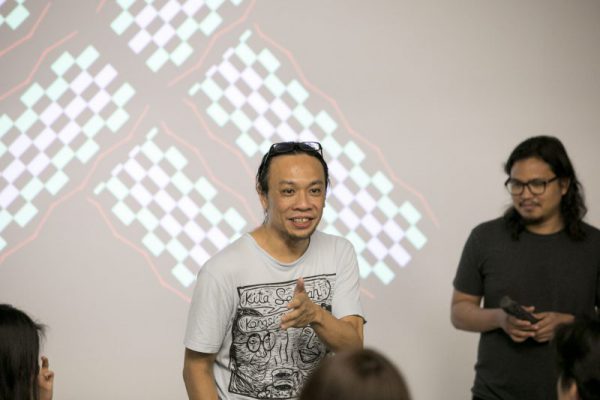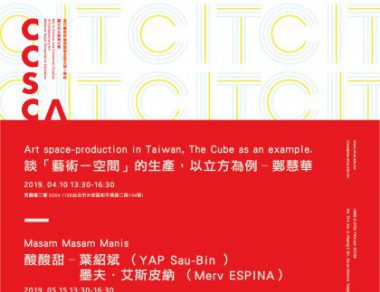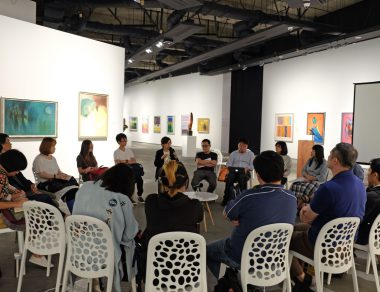By Issa WENG
“Curators’ Intensive Taipei 19: International Conference and Workshops” (CIT19) commenced on May 18, 2019 at the Museum of National Taipei University of Education. Organized around critical thinking, and held over the course of six months from May to October with six workshops and one 3-day international forum, the workshops extends the efforts of organizers National Culture and Arts Foundation and Taipei Fine Arts Museum as the largest curatorial funding mechanism and pioneer of curatorial thinking for the past twenty years, managed by independent art space TheCube Project Space, in collaboration with educational partner Critical and Curatorial Studies of Contemporary Art program at National Taipei University of Education, connecting curatorial education and praxis to counter the multiplicities of contemporary curatorial methods, and create platforms of international dialogue and exchange. Many short-term “curatorial intensives” have sprung up in recent years, with participants attending one-week courses, bombarded with large amounts of curatorial theory and practical knowledge over a very short time. CIT19 in comparison seeks to be more “extensive,” replacing “intensive” with “slow learning,” with the objective of expanding the dimensions of thinking with time. Furthermore, by instating two lecturers, thinking is allowed interference and collision, setting the grounds for a “double-slit experiment”(1) within contemporary curating. This series of articles seeks to invoke the concerns, divergence, and contradictions that occur during these workshops in substitute of factual accounts, in hopes that ambiguity—zones of potential—can be shared with its readers.

The first workshop focuses on the perspective of interculturality: How can curators engage or address the alternative and multiplicities of Southeast Asia beyond the scope of a single survey exhibition? Artist-curator YAP Sau Bin and Merv Espina lead participants in response to these inquiries through case studies, literature, mind maps, writing haiku, and other methods. Both draw from their collaborations with The Japan Foundation—”ESCAPE from the SEA” (2017) and “SUNSHOWER: Contemporary Art from Southeast Asia 1980s to Now” (2018), providing insight into the power dynamics in productions of large, international exhibitions.
Remove the painting, no explanation.
“I would like to share a failed experience, and let you know what you should not do.” YAP Sau Bin, as one of the main curators, begins the serious topic of art censorship with self-deprecating humor. Sabah Tanah Air-ku (Sabah, My Homeland) by the art collective Pangrok Sulap was removed on the second day of the opening of “ESCAPE from the SEA,” uproar ensued after no statement was issued by the organizers.(2) “ESCAPE from the SEA” was originally part of “Condition Report” (2015-2018), a large-scale curatorial project of The Japan Foundation. In the first phase of “Condition Report,” large-scale collaborative exhibitions were held in four cities: Jakarta, Kuala Lumpur, Manila and Bangkok, with senior curators guiding emerging curators. “ESCAPE from the SEA” was the project in Kuala Lumpur. The second phase would then showcase projects curated independently by the emerging curators. As a diptych, when one of the two panels of Sabah Tanah Air-ku was removed from Art Printing Works, the other remained on view at National Visual Arts Gallery. After a lack of statement from the organizers for weeks, the artists removed the other work and withdrew from the show. The disappearance of works is not uncommon in Malaysia.(3) However, in this case the offender was not an official institution, but The Japan Foundation, which had long supported Southeast Asian contemporary art. Who has the right to remove work? Who is responsible for protecting work? What invalidates a curator’s power and responsibility? Political powers may even cross national borders. In the case of “SUNSHOWER,” Merv Espina shares, the Vietnamese-American artist Tiffany Chung was put under pressure by the Vietnam Embassy in Tokyo during installation, and her work was partially exhibited. Through out the process, the artist’s requests were ignored and Chung was requested to remain silent.(4)

Silence only serves to heighten the power disparity of “no explanation,” triggering an “unspeakable” fear. Phantoms within systems of artistic production are awakened by silence, self-censoring attached to fear, while the less perceptible subject of “latent colonization” exercises its power through the mechanism of (cultural) production.(5)
The Elephant in the Room
“Now I’m showing you the elephant in the room,” Espina jokes, referring to Apichatpong Weerasethakul and Chai Siris’ work by the same title in “SUNSHOWER” –A life-size sculptural elephant hanging in space as his opening, citing criticisms of the exhibition from The Japan Times. Writer John L. Tran affirms the importance and contribution of historical disclosure of the largest study of Southeast Asian Contemporary Art to date, but is dubious of the “overall tone of ‘supporting’ the voice of the subaltern,” asserting that ” public and private institutions in Japan do not have a convincing track record of being able to see foreign cultures other than as a resource within a social Darwinist paradigm of competition and ranking. The very act of creating a major event such as “SUNSHOWER,” which imagines itself to be acting as a central metropolitan hub drawing in material from disparate and diverse cultures, is contrary to the spirit of critiquing globalization that informs many of the pieces.”(6) Tran further emphasizes, questions of “Why now?” and “Why here” call for rigorous examination in holding the exhibition in an economic center like Tokyo.

The exhibition “SUNSHOWER,” in a curiously outspoken attitude, even “commemorates the 50th Anniversary of ASEAN (The Association of Southeast Asian Nations)” on its official website. Upon further examination behind one of Asia’s most prestigious cultural institutions giving in to the power of regimes, one finds the role of strategic cultural diplomacy in the history of The Japan Foundation. The Japan Foundation was established in 1972 as part of the Ministry of Foreign Affairs with 10 billion Japanese Yen, in response to anti-Japanese sentiment caused by Japanese expansion in Southeast Asian economies. Prime Minister Takeo Fukuda increased funding by 10 billion Japanese Yen during “Fukuda Doctrine,” and comprehensive diplomatic strategies in Southeast Asia have included education, academics and culture since the 1980s. The second site of traveling exhibition “SUNSHOWER,” Fukuoka City Art Museum also collected a large number of works from ASEAN countries during this period. With the rise of neoliberalism, the institution shifted to regional collaborations and forums related to “global futures” in the 1990s.(7) With culture as currency, art is only a tool for diplomacy. In the interests of politics and economy, art is forced to cede. Can it be that the Greater East Asia Co-Prosperity Sphere has not dissipated, but has been resurrected through the neoliberalism of manufactured cultural exchange and international connections?
With this understanding, if we shift our focus to the fostering of Southeast Asia contemporary art in the 1970s and its relationship within art ecology, there is much to be concerned. In recent years the foundation’s cultural support has shifted from artwork to curators. “ESCAPE from the SEA” and “SUNSHOWER” are both admirable curating and training experiments in scale, time and spirit. Curators hold a key role in cultural production; controlling the production mechanism of curators is akin to nipping cultural discourse at its source. The Japan Foundation Kuala Lumpur is one of the few organizations that provide curatorial education. The opportunity to participate in this program is an international link to the contemporary art world, and a precious opportunity for many emerging curators. On the other hand, because there are so few comparable programs in this region, emerging curators may be compelled to comply with “expectations” or self-censorship for the sake of their futures.
A Call to the Multitude
How can curators avert self-spectaclization, advance beyond barriers of post-colonial theories, and dependence on systems of value and class? The lecturers suggest examining the production mechanism, power relations and dynamics in them. Curators originated as reactionary to institutions and systems.(8) YAP Sau Bin and Merv Espina share their practice with Rumah Air Panas and Green Papaya Art Projects, in thinking about curatorial possibilities alongside/outside of institutions and systems.
Espina introduces “VIVA EXCON” (Visayas Islands Visual Arts Exhibition and Conference), an artist-funded art festival established by artists in the Philippines in the 1990s during the biennial boom, providing a different perspective in an increasingly exhaustive and monolithic discourse. In around 2000, Yap notes, with curators and artists traveling in Southeast Asia, and Kuala Lumpur as an important transit point for low-cost carriers to many Asian cities, Rumah Air Panas used this advantage to “intercept” these people, holding lectures and workshops. This expanded a network through the friendships of artists and curators. Their approach provides a route for artists and curators hoping to distort economic powers within the context of globalization. Through friendships, self-organizing and global connections, the imagining of exhibition space expands to function as a network node. The notable exhibition “Thaitai: A Measure of Understanding” of collaborations between Open Contemporary Art Center and JIANDYIN in 2013 is a similar example in Taiwan.
In my inquiries on acquaintance with the Taiwanese art community, Yap mentions that there are many Malaysian students studying in Taiwan since the 1960s, so they are not unfamiliar with Taiwan; one can even find magazines “ARTCO” series and “Artist” in Malaysia. However, YAP’s first awareness of Taiwanese curators was from TSAI Ming-liang at the Venice Biennale. 9 As friends became students at Taipei National University of the Arts, there were contacts with teachers Manray HSU and Lin Hongjohn, and latter in-depth connections through the Southeast Asian residencies of Nobuo Takamori, GUO Jau-lan , Rikey CHENG, and Open-Contemporary Art Center, and friendships that were developed. YAP’s understanding of Taiwan, reflects the developmental history between Taiwan and Southeast Asian art communities to some extent.
In 2022 documenta 15 in Kassel will be curated by the Indonesian art collective ruangrupa. Press have proclaimed the rise of Southeast Asia/artist collectives. YAP believes, “However, if we return to power dynamics and the production mechanism, there are connections and relations with members of the selection committee that signify that this is no accident, and perhaps documenta has reached a tipping point that needs to be undermined by Southeast Asia. [laugh] It is worth noting ruangrupa differentiates itself from other artist collectives in its degree of organization, with core members setting five-year goals. ruangrupa is known for their conflict with institutions since inception, and I look forward to seeing what they do.” Espina asserts, “May they survive this battle. [laugh] Even artist collectives will inevitably encounter issues of power structure among its members. Green Papaya Art Project set an end date at its start, as a way to stay relevant. Whenever faced with a major decision (or major temptation, such as an invitation to a well-known international biennale), this timeline forces members of the importance and urgency of the matter.”
Humanity beyond professionalism
Returning to the removal of the painting, a curator is someone who cares, but what would you care about if you were the curator? In response to this inquiry, Yap illuminates the event by emphasizing the humanity in curatorial work in defending curatorial discourse and protecting the livelihood of friends in institutions. “You have to think beyond yourself; it is a complex relationship involving many others.” “Please construct a haiku and write down what curating is for you.” One participant from Kaohsiung Museum of Fine Arts wrote “Show me the money, the money show” vividly relaying a moment when art is influenced by political power. (10) “SUNSHOWER” is currently on view at the Kaohsiung Museum of Fine Arts, a rare opportunity and excellent study for workshop participants. In regards to the relatively recent idea of “nation” in Southeast Asia and frameworks beyond “borders,” the lecturers recommend the critiques published in Art Accrediting, a publication issued by the museum. (11)
This workshop enlightens inquiries on how one truly accepts an incomprehensible gap within cultural exchange. Cultural exchange under the circumstance of unbalanced resources and uneven powers would only be hypocrisy, while its presumed results will (or can only) be dictatorial. Only when we accept misunderstandings and obscurity, can we then start from the ground up, and encourage paths of mutual understanding, discarding frameworks of national competition, and establish subjectivity in constructing cultural discourse.
(Author: Issa WENG / Translated by Daphne CHU, published on ARTWAVE)
- The double-slit experiment is a “double path experiment,” in which a beam of light is cast through an opaque plate with two slits, and due to interference between these two light beams, a diffraction pattern is observed when it reaches the screen behind the plate. German physicists Claus Jönsson replaced photons with electrons in his double-slit experiment in 1961, and while electrons are particles, the interference showcased the same result as waves, subverting traditional assumption, and made way for new experiments and views of modern quantum mechanics.
- Terence Toh, “Malaysians finally get to view art collective Pangrok Sulap’s ‘controversial’ woodcuts in KL,” The Star Online, October 5, 2018.
- Brady Ng, “Seven artists pull out of censored Kuala Lumpur Biennale,” ArtAsiaPacific, November 24, 2017.
- For details of the process, please refer to the video of Vietnamese-American artist Tiffany Chung, “CIMAM 2017 Singapore, Day 3: Perspective 08, Tiffany Chung,” December 29, 2017, accessed May 18, 2019, https://vimeo.com/249056889
- HUANG Chien-Hung, “Issues of Latent Colonization and Political Economics in Globalization,” ARTCO Monthly, issue 247, April 2013, pp.97-99.
- John L. Tran, “Southeast Asian art gets its biggest showing in Japan,” The Japan Times, Jun 30, 2017; Nobuo Takamori, “After being drenched: Thinking about “Sunshower,”ARTouch, June 5, 2019, accessed June 11, 2019, https://artouch.com/view/content-11279.html
- DING Zhaozhong, “Japanese Cultural Diplomacy towards ASEAN,” Around Southeast Asia, October 2008, pp.8-12.
- During his directorship at Kunsthalle Bern, Harald Szeemann curated the exhibition “Live in Your Head: When Attitudes Become Form: Works-Concepts-Processes-Situations-Information,” opening discussions for curating as cultural production in contemporary art, which was controversial at the time. The next year he left the museum and became an “exhibition maker,” independent of an institution. Szeemann is hailed as the Father of Independent Curating by latter generations.
- The 52nd edition of the Taiwan Pavilion at Venice Biennale “ATOPIA,” was curated by Lin Hongjohn, with participating artists TSAI Ming-liang, Tang Huang-chen, Lee Guo-min, Huang Shih-chieh, and VIVA.
- While visiting the exhibition “SUNSHOWER” at Kaohsiung Museum of Fine Arts, Kaohsiung mayor HAN Kuo-yu led city officials in chanting the slogan “Enrich Kaohsiung” inside the museum, during their photo op, which has caused dispute. HUANG, Chia-lin, KO, Yu-hao, and Sherry HSIAO. “Kaohsiung city councilor snubs mayor,” Taipei Times, May 16, 2019, accessed July 26, 2019, http://www.taipeitimes.com/News/taiwan/archives/2019/05/16/2003715219
- Ong Jo-Lene, “Sea-change: Reflections on co-curating SUNSHOWER,” Art Accrediting, Bimonthly of Kaohsiung Museum of Fine Arts, issue 85, April 2019.




